

Legislative Advising & Thought Leadership Initiatives – Expertise Needed. Okt. The Internet of Things has promised to turn our everyday interactions with stuff into data for logistical and marketing applications.

But now that more and more corporations, including Diageo and Mondelez, have tested actual web-connected products in the market, the industry is approaching the next stage of connected appliances and food packaging. That means figuring out where all that information will go and how it will be used. IoT platform company Evrythng sees a home for data generated by connected thermostats, bottles of booze, designer handbags and washing machines in first-party marketing databases. The firm is partnering with Trueffect, a digital ad firm specializing in first-party data targeting, to work towards devising ways marketers can use data gathered when consumers use their products.
The firms hope to directly communicate with those consumers and, yes, perhaps target ad messages to them. According to Mr. According to Mr. Data-Related SOA Design Patterns (Audio) SOA Patterns - Canonical Schema Bus. Co-existent application of Enterprise Service Bus, Decoupled Contract, Contract Centralization, and Canonical Schema.
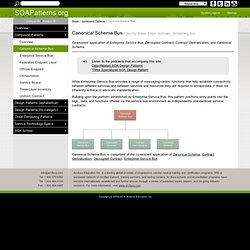
Listen to the podcasts that accompany this site Data-Related SOA Design Patterns Three Specialized SOA Design Pattern While Enterprise Service Bus provides a range of messaging-centric functions that help establish connectivity between different services and between services and resources they are required to encapsulate, it does not inherently enforce or advocate standardization. Building upon the platform established by Enterprise Service Bus, this pattern positions entry points into the logic, data, and functions offered via the service bus environment as independently standardized service contracts. SOA Patterns - Canonical Schema. How can services be designed to avoid data model transformation?

Problem Services with disparate models for similar data impose transformation requirements that increase development effort, design complexity, and runtime performance overhead. Solution Data models for common information sets are standardized across service contracts within an inventory boundary. Application Design standards are applied to schemas used by service contracts as part of a formal design process. Impacts Maintaining the standardization of contract schemas can introduce significant governance effort and cultural challenges.
Architecture Inventory, Service Listen to the podcasts that accompany this site Multiple services implemented as Web services have standardized XML schema definitions as a result of applying this pattern. Related Patterns in This Catalog Canonical Protocol, Data Model Transformation, Domain Inventory, Enterprise Inventory, Schema Centralization, Service Messaging Related Patterns in Other Catalogs. SOA Patterns - Contract Centralization. How can direct consumer-to-implementation coupling be avoided?
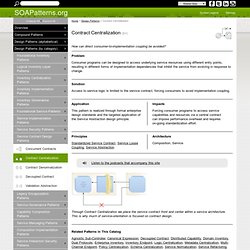
Problem Consumer programs can be designed to access underlying service resources using different entry points, resulting in different forms of implementation dependencies that inhibit the service from evolving in response to change. Solution Access to service logic is limited to the service contract, forcing consumers to avoid implementation coupling. Application This pattern is realized through formal enterprise design standards and the targeted application of the Service Abstraction design principle.
Impacts Forcing consumer programs to access service capabilities and resources via a central contract can impose performance overhead and requires on-going standardization effort. SOA Patterns - Decoupled Contract. How can a service express its capabilities independently of its implementation?
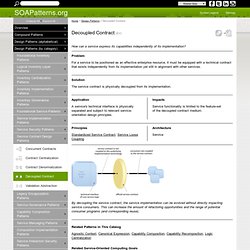
Problem For a service to be positioned as an effective enterprise resource, it must be equipped with a technical contract that exists independently from its implementation yet still in alignment with other services. Solution The service contract is physically decoupled from its implementation. Application A service's technical interface is physically separated and subject to relevant service-orientation design principles. Impacts. SOA Patterns - Enterprise Service Bus. An enterprise service bus represents an environment designed to foster sophisticated interconnectivity between services.
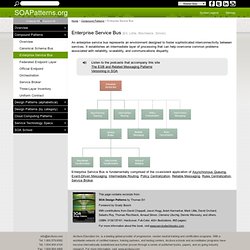
It establishes an intermediate layer of processing that can help overcome common problems associated with reliability, scalability, and communications disparity. Listen to the podcasts that accompany this site The ESB and Related Messaging Patterns Versioning in SOA Enterprise Service Bus is fundamentally comprised of the co-existent application of Asynchronous Queuing, Event-Driven Messaging, Intermediate Routing, Policy Centralization, Reliable Messaging, Rules Centralization, Service Broker. SOA Patterns - Canonical Schema. Enterprise Integration Patterns - Canonical Data Model. I am designing several applications to work together through Messaging.
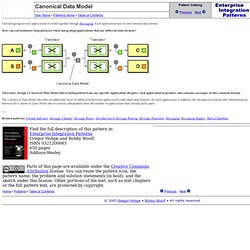
Each application has its own internal data format. How can you minimize dependencies when integrating applications that use different data formats? Therefore, design a Canonical Data Model that is independent from any specific application. Require each application to produce and consume messages in this common format. The Canonical Data Model provides an additional level of indirection between application's individual data formats.
SOA Patterns - Schema Centralization. How can service contracts be designed to avoid redundant data representation?
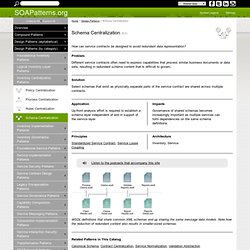
Problem Different service contracts often need to express capabilities that process similar business documents or data sets, resulting in redundant schema content that is difficult to govern. Solution Select schemas that exist as physically separate parts of the service contract are shared across multiple contracts.